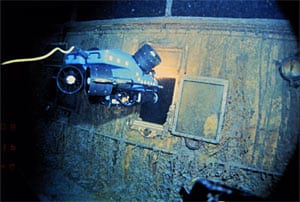News Releases
Four WHOI Researchers Recognized for Contributions to Science and Engineering
Four researchers have been recognized by the Woods Hole Oceanographic Institution (WHOI) for their contributions to ocean sciences research and engineering. All will receive funding provided by the endowed awards […]
Read MoreMercury and Fish
WHOI scientists and colleagues at the University of Connecticut have found the first connection between mercury levels in freshwater fish and atmospheric mercury pollution, most of which is derived from […]
Read MorePicture Perfect Plankton
The Large Area Plankton Imaging System, or LAPIS, is providing biologists with a new tool to study plankton to depths of 500 meters (1,640 feet). Until now, fragile gelatinous animals […]
Read MoreColossal Corer
A 50-meter (165-foot) long coring system nearing completion at WHOI will enable paleoceanographers to reconstruct past climates back tens of millions of years and expand the coring capabilities of the […]
Read MoreBeaked Whales Perform Extreme Dives to Hunt Deepwater Prey
A study of ten beaked whales of two poorly understood species shows they dive much deeper and longer than reported for any other air-breathing species, a finding of particular interest since beaked whales stranded during naval sonar exercises have been reported to have symptoms of decompression sickness.
Read MoreHarmful Algal Bloom (Red Tide) Models and Forecasts to be Expanded in Gulf of Maine
A new observation and modeling program focused on the southern Gulf of Maine and adjacent New England shelf waters could aid policymakers in deciding whether or not to re-open, develop, […]
Read MoreLessons from the 2004 Indian Ocean Tsunami Topic of Public Forum
How coastal communities manage risks associated with major tsunamis is an issue of global importance following the devastating 2004 Indian Ocean tsunami that killed an estimated 200,000 people and caused […]
Read MoreAntique Whale Oil Provides Insights to Origin of Pre-Industrial Chemicals
One of the last remaining New England whaling ships has provided unexpected insights into the origin of halogenated organic compounds (HOCs) that have similar chemical and physical properties as toxic […]
Read MoreRapid Sea Level Rise in the Arctic Ocean May Alter Views of Human Migration
Scientists have found new evidence that the Bering Strait near Alaska flooded into the Arctic Ocean about 11,000 years ago, about 1,000 years earlier than widely believed, closing off the […]
Read MoreDigital Tags Provide Evidence that Narwhals May Produce Signature Vocalizations for Communication
Scientists have found preliminary evidence that narwhals, Arctic whales whose spiraled tusks gave rise to the myth of the unicorn, produce signature vocalizations that may facilitate individual recognition or their […]
Read MoreABE Joins Alvin and Jason at Sea
The Autonomous Benthic Explorer, ABE, one of the first autonomous underwater vehicles (AUVs) to routinely work in the deep ocean, has joined the U.S. National Deep Submergence Facility, providing ocean […]
Read MoreTracking Killer Whales with Technology
WHOI researchers will use a small, non-invasive piece of technology, the digital archival tag or D-tag, in November to tag free-ranging killer whales in northern Norway. The researchers will record […]
Read MorePropane-producing Bacteria Found on the Seafloor
Scientists from the University of Bremen in Germany and Woods Hole Oceanographic Institution (WHOI) and have found microorganisms in buried sediment on the ocean floor producing abundant supplies of the […]
Read MoreGliders Are Changing the Way Ocean Observations are Made
A fleet of gliders from WHOI’s Autonomous Systems Laboratory is quietly monitoring the ocean near Monterery Bay, California as part of a month-long experiment to learn more about ocean conditions […]
Read MoreIsland Ferries Take on Role of Research Vessels Collecting Data about Nantucket Sound
Ferries that connect Cape Cod and the islands of Martha’s Vineyard and Nantucket are taking on another role – research vessels.
Woods Hole Oceanographic Institution (WHOI) biologist Scott Gallager and colleagues […]
Read MoreA First Responder on the Ocean Floor
The Towed Digital Camera and Multi-Rock Coring System, or TowCam, was developed by scientists and engineers at WHOI to meet the U.S. oceanographic community’s need for an imaging and sampling […]
Read MoreNatural Petroleum Seeps Offer Clues to the Past and the Future
Just a half mile off California’s coast near Santa Barbara, and in coastal areas around the world, natural petroleum seeps are releasing an astonishing amount of methane gas and oil […]
Read MoreUndersea Vehicles to Study Formation of Gold and Other Precious Metals On the Pacific Ocean Floor
An international team of scientists will explore the seafloor near Papua New Guinea in the western Pacific Ocean later this month with remotely operated and autonomous underwater vehicles, investigating active […]
Read MoreWoods Hole Engineering Team from Titanic Discovery to be Honored
The underwater research vehicle Jason Jr., which gained international attention for its exploration inside the wreck of the R.M.S. Titanic in July 1986, and its engineering team from Woods Hole […]
Read MoreStudy Looks at Ways to Sustain Lobster Fishery
In the world of the lobster fishery, less may indeed be more. A new study may give hope to lobstermen struggling with declining lobster stocks, suggesting new ways that might […]
Read MoreCaribbean Corals and Climate Change
Climate scientists are finding interesting clues to ancient climates in the corals of Honduras. During a trip earlier this month, they drilled cores from Montastrea (star corals) and Diploria (brain […]
Read MoreArctic Adventure: Following Bowhead Whales
WHOI scientists will be working on the continental shelf near Barrow, Alaska from mid-August to mid-September, trying to determine the oceanographic conditions that make this region a favorable feeding environment […]
Read MoreSilent Stingers
Summer brings millions to the beach, and among the creatures often found in coastal waters are jellyfish. One of the most beautiful but potentially dangerous is Physalia physalis, commonly known […]
Read MoreA New Era in Observing the Ocean
Marine scientists have their fingers crossed that a long-planned Ocean Observatories Initiative (OOI) will make it through the federal budget process this summer and fall and become a reality. OOI, […]
Read More
